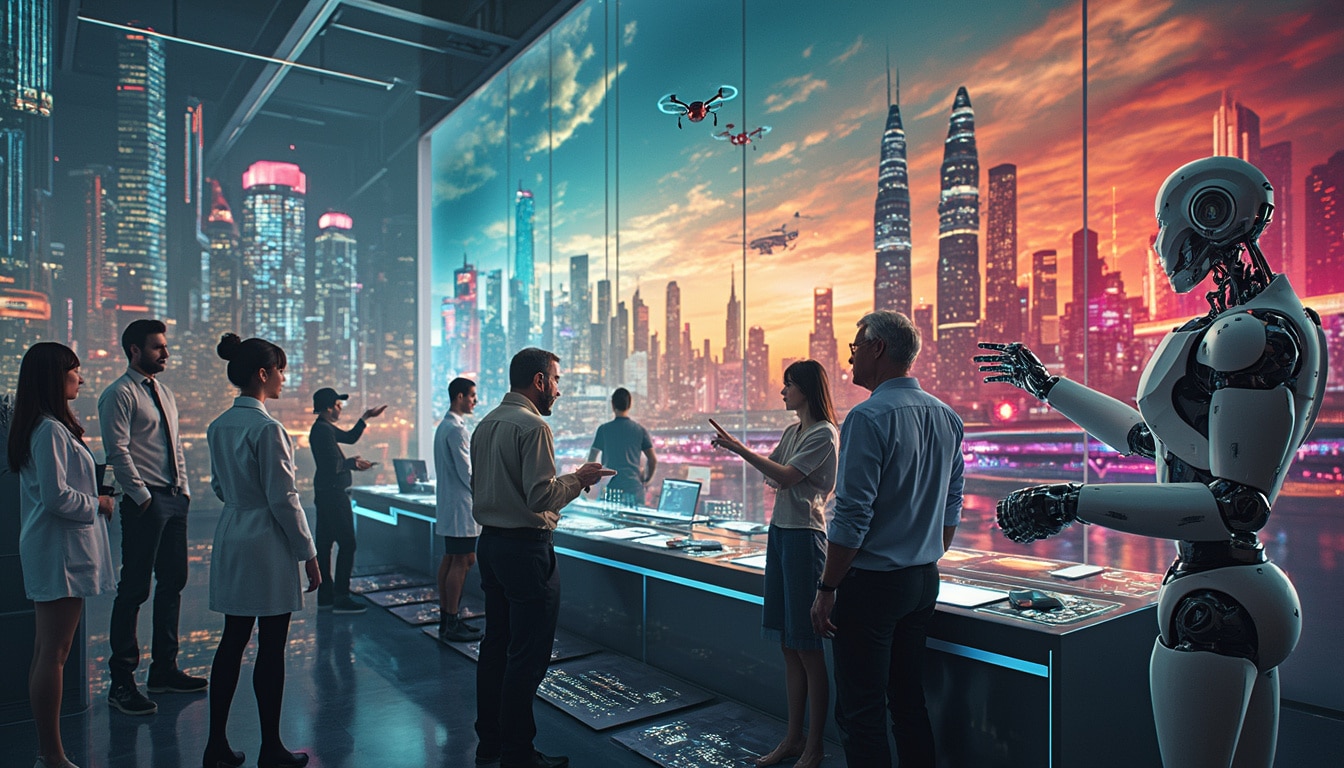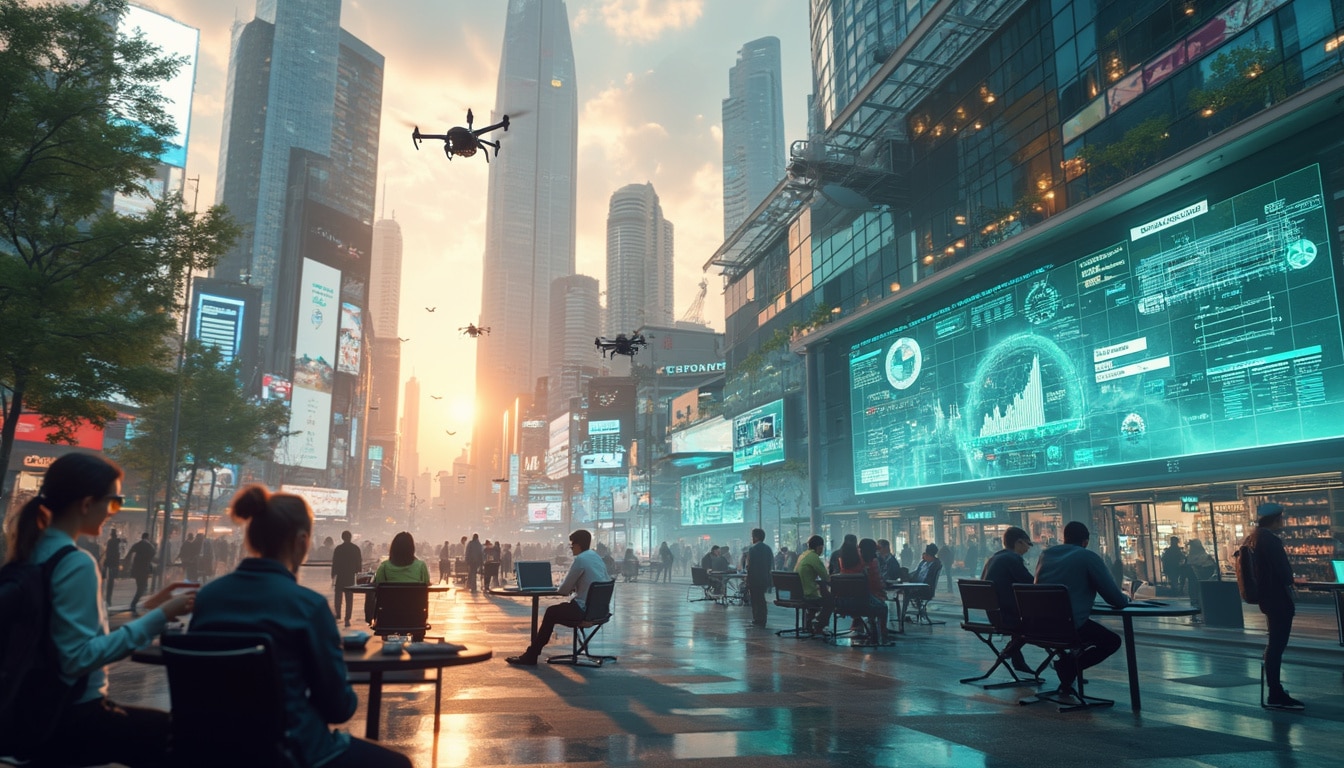The artificial intelligence market is booming, with forecasts reaching 4.8 trillion dollars by 2033.This phenomenal growth is driven by a few major players who concentrate investments.This dominance could exacerbate inequalities between countries, creating a significant technological divide.
AI-driven automation often favors capital over labor, thereby reducing the competitive advantage of cheap labor in developing countries. According to the report’s authors, to prevent these nations from being left behind, it is essential to include them in discussions about rules and ethics of AI. Furthermore, the UN warns that up to 40% of jobs could be affected by AI. Nevertheless, this technology also offers the potential to create new industries and empower workers if investments are made in training. The future of AI will largely depend on the political and economic choices we make starting now.

Table of Contents
ToggleWhat does the UN report reveal about the impact of AI on employment?
According to a recent report from the United Nations Conference on Trade and Development, the artificial intelligence (AI) market could reach an impressive value of 4.8 trillion dollars by 2033. This figure emphasizes the growing scope of AI in the global economy and its potential to transform various sectors. However, this rapid expansion is not without consequences. The report highlights that the wealth generated by AI is likely to concentrate in the hands of a few dominant players, thereby exacerbating inequalities between countries and regions.
This concentration of capital around AI could widen the economic gap between developed nations and developing countries, where resources for adopting and integrating these technologies are limited. To illustrate this situation, OpenTheDigital offers marketing and communication strategies that enable companies to maximize their impact, but access to such resources remains uneven.
Meanwhile, the UN report points out that nearly 40% of jobs could be affected by AI. This includes positions in various sectors such as manufacturing, financial services, and even some aspects of digital marketing. This transformation of the labor market raises crucial questions about how workers and national economies can adapt to these changes.
How does AI-driven automation favor capital over labor?
One of the key points of the UN report is that the benefits of AI-driven automation tend to favor capital rather than labor. In other words, investments in AI primarily benefit companies and investors, thus increasing their profit margins while reducing opportunities for workers. This dynamic can lead to rising income inequalities, especially in countries where cheap labor constitutes a competitive advantage.
For example, in developing countries, the introduction of AI could decrease the demand for unskilled labor, making local economies less competitive in the global market. To delve deeper into this issue, OpenTheDigital explores the indispensable impact of AI in digital marketing, showing how small businesses can sometimes be left behind in the face of large technologically advanced platforms.
Moreover, automation can lead to a reduction in stable jobs, pushing workers toward temporary contracts or precarious employment. This not only affects individuals’ financial security but can also have social repercussions, increasing economic stress and reducing overall quality of life.
What measures does the UN propose to mitigate the negative impacts of AI on employment?
To prevent developing countries from being left behind in the AI revolution, the UN report recommends active participation of these nations in discussions on rules and ethics of AI. This inclusion is essential to ensure that the policies implemented take into account the specificities and needs of less technologically advanced economies.
One of the major recommendations is to invest in the training and skill development of workers. By offering retraining programs, countries can help their workforce adapt to the new requirements of the labor market. This includes not only technical skills related to AI but also transversal skills such as problem-solving and critical thinking.
Another point mentioned by the UN is the need to strengthen technological infrastructures in developing countries. This may involve modernizing telecommunication networks, providing access to advanced technologies, and creating ecosystems conducive to innovation. For example, OpenTheDigital analyzes how the acceleration of semiconductor manufacturing in the United States impacts cloud computing, a crucial area for technological development.
What opportunities does AI create despite the threats to employment?
Although AI poses a threat to a significant portion of current jobs, it also paves the way for the creation of new industries and professional opportunities. Technology innovation driven by AI can lead to the emergence of entirely new sectors requiring specialized skills and offering well-paid jobs.
For instance, the development of smart advertisements and AI-based marketing optimization tools offers unprecedented opportunities for digital marketing professionals. OpenTheDigital highlights the essential role of AI in enhancing the impact of advertising campaigns, opening new prospects for specialists in the field.
Additionally, AI can empower workers by automating repetitive tasks, thus allowing professionals to focus on more creative and strategic aspects of their work. This can lead to increased productivity and job satisfaction, while providing enriching career opportunities.
However, for these opportunities to materialize, it is crucial that investments in training and skill development are maintained. Without adequate support, workers may risk not fully benefiting from the advantages of AI, and inequalities could continue to widen.
How can countries prepare their workforce for the era of AI?
Preparing the workforce is essential to minimize the negative impacts of AI and maximize its benefits. Countries must adopt a proactive approach by investing in education and continuous training. Educational programs should include courses on emerging technologies, programming, and data analysis to equip students with the necessary skills from the start of their careers.
Moreover, companies play a crucial role in the workforce transition. By collaborating with educational institutions, they can contribute to the development of training programs tailored to the needs of the labor market. For example, OpenTheDigital examines how questionable practices by some companies can impact consumer trust and, by extension, influence training and employment strategies.
Additionally, governments can implement support policies to encourage retraining. This could include grants for companies that invest in training their employees, as well as tax incentives for individuals seeking to acquire new skills.
Which industries are most at risk from the rise of AI?
Some industries are particularly vulnerable to the impact of AI due to the repetitive and automatable nature of many tasks they encompass. Manufacturing is a classic example, where robots and automated systems can replace many traditional production lines. Similarly, the financial services sector increasingly uses AI for tasks such as data analysis, thus reducing the need for human intervention.
In the field of digital marketing, AI not only creates more targeted and effective advertisements but also automates entire aspects of marketing campaigns. This could reduce the need for certain traditional roles in the sector, while demanding new skills oriented toward data analysis and management of advanced technologies.
Moreover, sectors such as logistics and transportation are also subject to major transformations due to AI. Autonomous driving and optimized management systems can reduce the need for drivers and managers while improving the overall efficiency of these industries.
To better understand the specific impact on each industry, readers can consult the best articles and podcasts of the week offered by OpenTheDigital, providing detailed analyses and varied perspectives on the changes induced by AI.
What strategies can companies adopt to adapt to AI?
To navigate the era of AI, companies must develop effective strategies that integrate this technology while preserving existing jobs and creating new opportunities. A key approach is to adopt a marketing and communication strategy that is adapted, as proposed by OpenTheDigital. By maximizing the impact of marketing campaigns through AI, companies can not only increase their efficiency but also create new market niches.
Moreover, investing in smart automation can help companies optimize their operational processes, reduce costs, and improve the quality of products and services. However, it is crucial to do so ethically and responsibly, considering the social and economic impacts of these technologies.
For technology companies, collaborating with AI experts and staying at the forefront of innovations is essential. This includes establishing internal training programs to develop employee skills and fostering a culture of continuous innovation.
Finally, companies should also focus on data management and privacy protection, ensuring that the integration of AI complies with regulations and ethical standards in place. Transparent and secure data management can enhance consumer trust and encourage wider adoption of AI technologies.
What future awaits employment in an AI-dominated world?
The future of employment in an AI-dominated world is both promising and uncertain. On one hand, AI offers unprecedented opportunities for innovation, the creation of new sectors, and improving working conditions by automating tedious tasks and enabling workers to focus on higher-value missions.
On the other hand, the risk of economic inequality and loss of traditional jobs remains a major concern. Countries, businesses, and individuals will need to collaborate to establish effective support systems, including retraining, continuous education, and appropriate social protection policies.
It is also crucial to promote an inclusive approach to AI development, where the benefits of this technology are shared equitably. This involves ensuring access to cutting-edge technologies, promoting a fair distribution of wealth generated by AI, and ensuring that technological advancements align with ethical and social values.
Ultimately, AI represents a profound transformation of our society and economy. By adopting responsible and inclusive approaches, it is possible to maximize the benefits of AI while minimizing its negative impacts, thus ensuring a future where technology and humanity coexist harmoniously.










